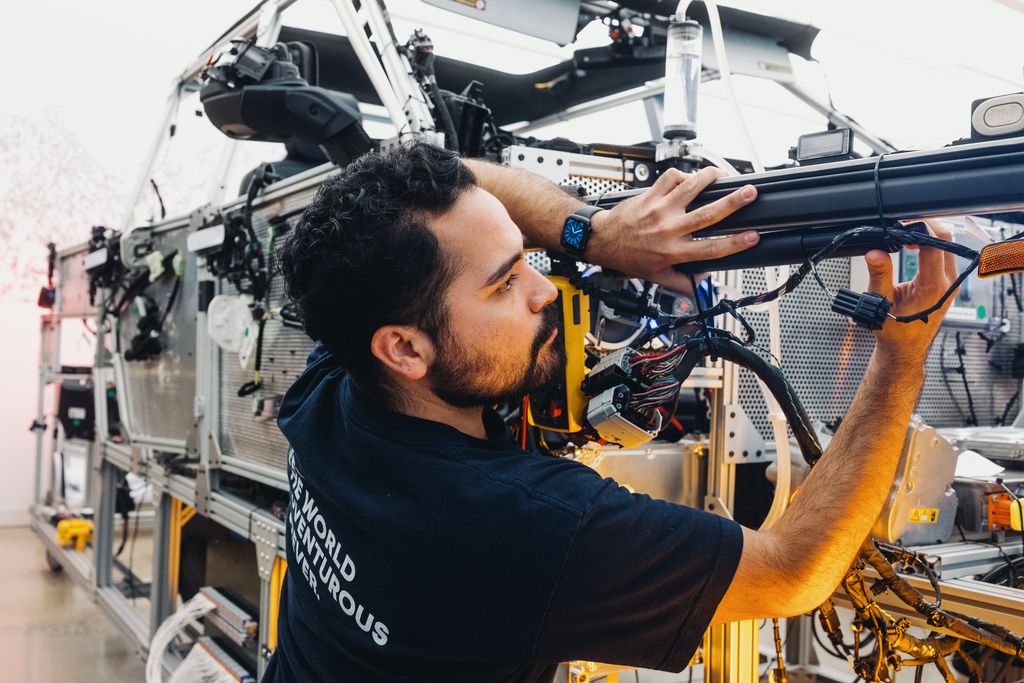- Rivian and Volkswagen said their co-developed software and vehicle architecture is already heading for winter testing and validation.
- The two companies formed the joint venture just one year ago.
- More than 1,500 employees in the U.S., Canada, Sweden, Serbia and Germany are racing to bring the tech to future Rivian, Volkswagen and Scout EVs.
The $5.8 billion joint venture between Rivian and the Volkswagen Group is off to a strong start, the companies said on Wednesday.
The JV, called Rivian and Volkswagen Group Technologies (RV Tech), was formed last November to develop next-generation software and electrical architecture. The JV not only wants to lower EV prices for consumers, but is also aiming to challenge the BYDs and Teslas of the world, which have left legacy automakers in the dust when it comes to software-defined vehicles.
But the Volkswagen Group, the parent company of several brands including Audi, Porsche and Bentley, wants to stage a comeback after its own repeated software struggles and failures. Its early efforts were mediocre at best, with its Cariad software division facing delays and layoffs. Now, the partnership with Rivian gives it a clean shot at developing next-gen software.
Photo by: Rivian
The companies said on Wednesday that they’re moving fast to bring the technology to market. The JV will begin winter testing for the co-developed systems in the first quarter of 2026. This will help them evaluate and validate the zonal architecture on prototype Volkswagen, Audi and Scout branded vehicles, and it will be the first time those engineering mules hit the road. In the future, the plan is for the architecture developed by RV Tech to underpin all future VW Group EVs.
“The joint venture is rapidly developing the architecture for our future software-defined vehicles,” Oliver Blume, the CEO of the Volkswagen Group, said in a statement. “A technological foundation has been created in just twelve months that will enable a new digital driving experience for our customers at accessible prices,” he added.

Photo by: Rivian
At the heart of this partnership is the development of a zonal architecture to underpin future VWs and Rivians. Zonal architecture centralizes computing into a few core vehicle “zones,” rather than a variety of domain-specific ECUs. This helps automakers reduce wiring, simplify vehicle design and make repairs easier. The more powerful computers can also enable autonomous driving features in the future and leave room for continuous improvements through over-the-air (OTA) software updates.
The architecture concepts for the first few VW Group EVs are finalized, Wassym Bensaid, Rivian’s chief software officer and a co-head of the JV, told InsideEVs at a media event on Wednesday. This first crop of EVs includes an Audi, Scout Motors’s first EV and the Volkswagen ID.Every1. The Audi and the Scout will feature very similar architectures with three zonal ECUs, Bensaid said, like the second-generation Rivian R1S and R1T.
The smaller and less feature-filled ID.Every1 will feature a single zonal ECU. Its development has come comparatively further along, according to Bensaid. It makes sense, since that vehicle should launch in 2027.

Volkswagen ID.Every1 concept
Photo by: Volkswagen
While RV Tech is focusing on getting the R2 and initial VW Group vehicles ready right now, its leadership sees huge opportunity in licensing out its software-defined vehicle technology to other automakers in the future. Bensaid said it could provide the “reference operating system” for the entire auto industry, just like Google did with Android for phones.
Rivian has already rolled out this technology in its second-generation R1S and R1T models. Its upcoming R2 mid-size SUV, which will lock horns with the ubiquitous Tesla Model Y, will showcase the fruits of this joint venture when it goes on sale in the U.S. in the first half of next year.
The first VW Group vehicles using the share electrical architecture will use similar foundational technology to the latest Rivian R1 vehicles. RV Tech says it is already working on its third-generation tech stack, which will feature even more streamlined electronics.
For Volkswagen, the production car based on the ID.Every1 concept will be the first to feature the JV’s zonal architecture when it goes on sale in Europe in 2027. It will also be among the very first software-defined vehicles (SDV) in the entry-level mass market segment.
Beyond that small car, Volkswagen is also planning to use this electrical architecture for all of its future Western-market EVs, including its upcoming Scalable Systems Platform (SSP), which will also underpin multiple Audi and Porsche vehicles and succeed the current Modular Electric Drive Matrix (MEB) and Premium Platform Electric (PPE). MEB is what underpins the Volkswagen ID.4, while more expensive models like the Audi Q6 E-tron ride on PPE.

Rivian Zonal Architecture
Over in China, the Volkswagen Group is partnering with Xpeng to co-develop SDVs to take on local rivals. And for Western markets, Rivian is helping Volkswagen fulfill a similar goal, as Chinese software is either banned or heavily restricted in some Western markets.
With this partnership, Volkswagen gets easy access to modern Rivian-developed software and vehicle architecture while giving Rivian access to massive amounts of capital. Rivian has yet to turn a profit from selling EVs, even though it’s edging closer to that goal with every passing quarter.
So even though the EV transition has been a rough ride for both companies, they’re not backing down just yet. With the Trump administration’s rollback of the $7,500 federal tax credit and the gutting of several other pro-EV policies, EVs now have to sell purely on merit. And on that front, Rivian and Volkswagen are both just getting started.
Additional reporting by Tim Levin.
Have a tip? Contact the author: suvrat.kothari@insideevs.com
Updated 5:30 pm ET with additional comments from Wassym Bensaid about RV Tech providing the “operating system” for the auto industry.


